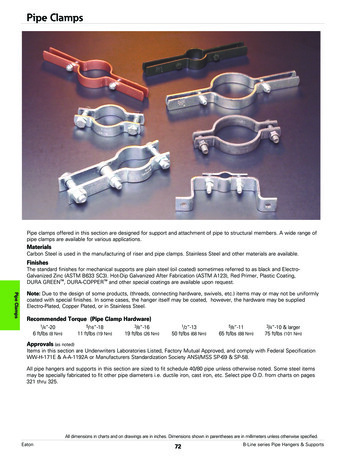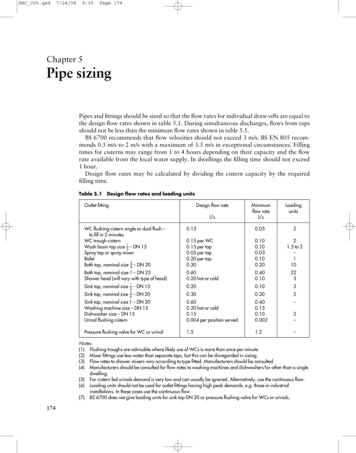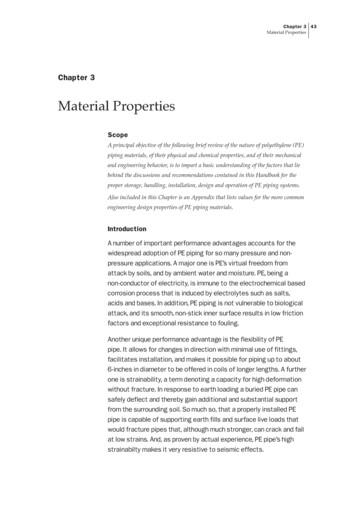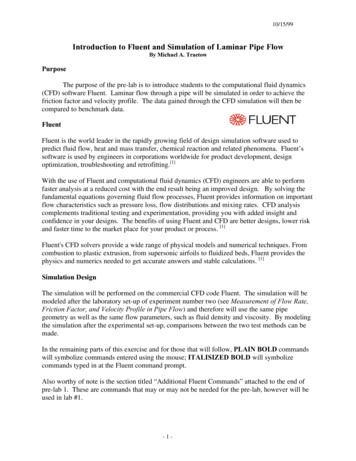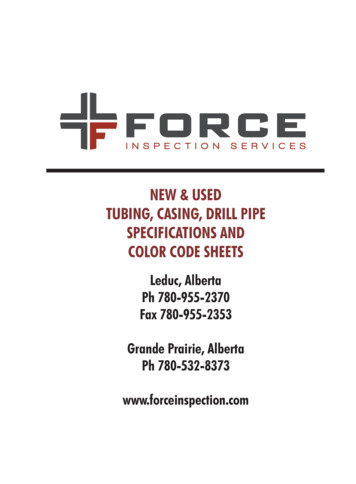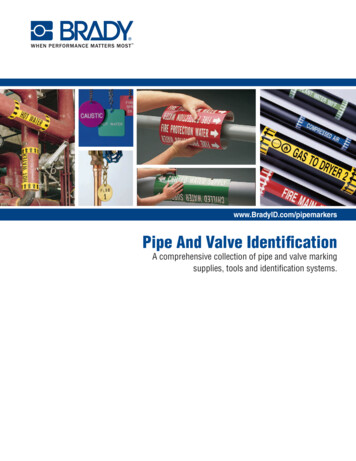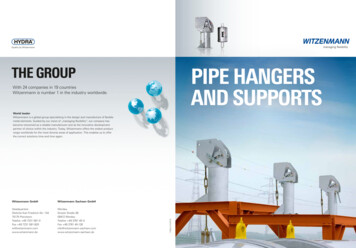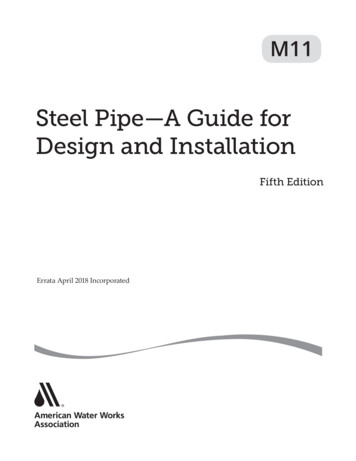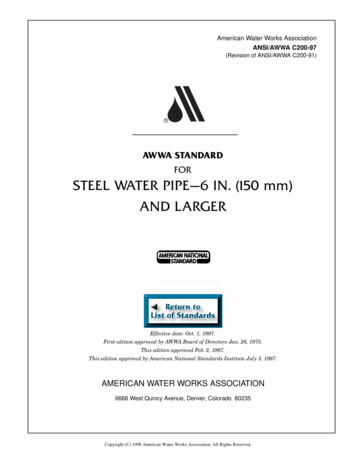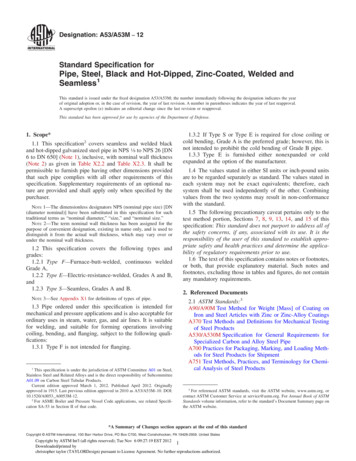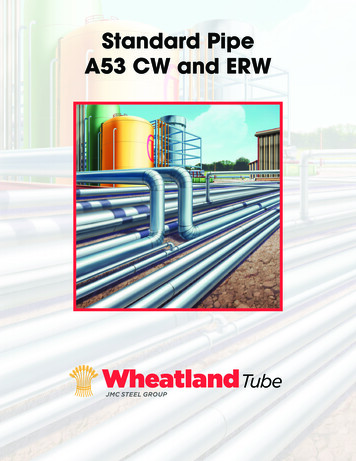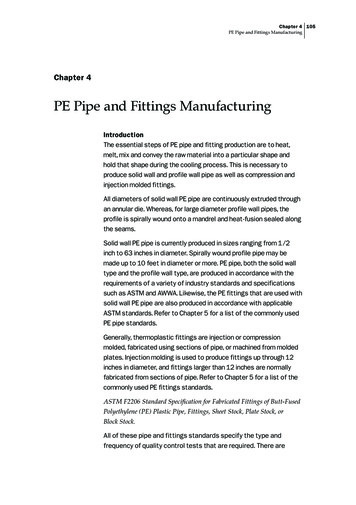
Transcription
Chapter 4 105PE Pipe and Fittings ManufacturingChapter 4PE Pipe and Fittings ManufacturingIntroductionThe essential steps of PE pipe and fitting production are to heat,melt, mix and convey the raw material into a particular shape andhold that shape during the cooling process. This is necessary toproduce solid wall and profile wall pipe as well as compression andinjection molded fittings.All diameters of solid wall PE pipe are continuously extruded throughan annular die. Whereas, for large diameter profile wall pipes, theprofile is spirally wound onto a mandrel and heat-fusion sealed alongthe seams.Solid wall PE pipe is currently produced in sizes ranging from 1/2inch to 63 inches in diameter. Spirally wound profile pipe may bemade up to 10 feet in diameter or more. PE pipe, both the solid walltype and the profile wall type, are produced in accordance with therequirements of a variety of industry standards and specificationssuch as ASTM and AWWA. Likewise, the PE fittings that are used withsolid wall PE pipe are also produced in accordance with applicableASTM standards. Refer to Chapter 5 for a list of the commonly usedPE pipe standards.Generally, thermoplastic fittings are injection or compressionmolded, fabricated using sections of pipe, or machined from moldedplates. Injection molding is used to produce fittings up through 12inches in diameter, and fittings larger than 12 inches are normallyfabricated from sections of pipe. Refer to Chapter 5 for a list of thecommonly used PE fittings standards.ASTM F2206 Standard Specification for Fabricated Fittings of Butt-FusedPolyethylene (PE) Plastic Pipe, Fittings, Sheet Stock, Plate Stock, orBlock Stock.All of these pipe and fittings standards specify the type andfrequency of quality control tests that are required. There are104-123.indd 1051/16/09 9:51:31 AM
106 Chapter 4PE Pipe and Fittings Manufacturingseveral steps during the manufacturing process that are closelymonitored to ensure that the product complies with these rigorousstandards. Some of these steps are discussed in the section ofthis chapter on quality control and assurance.Pipe ExtrusionThe essential aspects of a solid wall PE pipe manufacturing facility are presentedin Figure 1. This section will describe the production of solid wall pipe from rawmaterial handling, extrusion, sizing, cooling, printing, and cutting, through finishedproduct handling. Details concerning profile wall pipe are also discussed in theappropriate sections.Raw Materials DescriptionThe quality of the starting resin material is closely monitored at the resinmanufacturing site. As discussed in the chapter on test methods and codes in thishandbook, a battery of tests is used to ensure that the resin is of prime quality.A certification sheet is sent to the pipe and fitting manufacturer documentingimportant physical properties such as melt index, density, ESCR (environmentalstress crack resistance), SCG (slow crack growth), stabilizer tests, amongst others.The resin supplier and pipe manufacturer may agree upon additional tests to beconducted.Figure 1 Typical Conventional Extrusion Line104-123.indd 1061/16/09 9:51:31 AM
Chapter 4 107PE Pipe and Fittings ManufacturingExtrusion LineThe raw material, usually referred to as PE compound, is typically supplied to thepipe producer as non-pigmented pellets. PE pellets are stabilized for both heat andUV protection. Usually, color pigment is added to the pipe at the producer’s facility.In North America, the most common colors are black and yellow. The choice ofcolor will depend upon the intended application and the requirements of the pipepurchaser. Carbon black is the most common pigment used for water, industrial,sewer and above-ground uses. Yellow is reserved exclusively for natural gasapplications, although black with yellow stripes is also permitted for this application.Other colors are used for telecommunications and other specialty markets.All ASTM and many other industry standards specify that a PPI-listed compoundshall be used to produce pipe and fittings for pressure pipe applications. Acompound is defined as the blend of natural resin and color concentrate and theingredients that make up each of those two materials. The pipe producer maynot change any of the ingredients. In a listed compound, such as substituting adifferent color concentrate that could affect the long-term strength performance ofthe pipe. Any change to a listed formulation has to be pre-approved. These stringentrequirements ensure that only previously tested and approved compounds arebeing used.If the resin is supplied as a natural pellet, the pipe producer will blend a colorconcentrate with the resin prior to extrusion. In order to obtain a PPI Listing, eachmanufacturer producing pipe in this manner is required to submit data, accordingto ASTM 2837, to the PPI Hydrostatic Stress Board. A careful review of the data ismade according to PPI Policy TR-3 (5) to assess the long-term strength characteristicsof the in-plant blended compound. When those requirements are met, the compoundqualifies for a Dependent listing and is listed as such in the PPI Publication TR-4(6), which lists compounds that have satisfied the requirements of TR-3. Producersof potable water pipe are usually required to have the approval of the NSFInternational or an equivalent laboratory. NSF conducts un-announced visits duringwhich time they verify that the correct compounds are being used to produce pipethat bears their seal.Raw Materials HandlingAfter the material passes the resin manufacturer’s quality control tests, it is shippedto the pipe manufacturer’s facility in 180,000- to 200,000-pound capacity railcars,40,000-pound bulk trucks, or 1000- to 1400-pound boxes.Each pipe producing plant establishes quality control procedures for testingincoming resin against specification requirements. The parameters that aretypically tested include: melt flow rate, density, moisture content and checks for104-123.indd 1071/16/09 9:51:31 AM
108 Chapter 4PE Pipe and Fittings Manufacturingcontamination. Many resin producers utilize statistical process control (SPC) oncertain key physical properties to ensure consistency of the product.Resin is pneumatically conveyed from the bulk transporters to silos at the plantsite. The resin is then transferred from the silos to the pipe extruder by a vacuumtransfer system. Pre-colored materials can be moved directly into the hopper abovethe extruder. If a natural material is used, it must first be mixed homogeneously withan ultra-violet stabilizer to provide protection. Refer to the Handbook Chapter,a color concentrate.The resinmay be mixedthe details.color concentrate in a centralEngineeringPropertiesof Polyethylene,forwithfurtherblender remote from the extruder or with an individual blender mounted above theextruder hopper. The blender’s efficiency is monitored on a regular basis to ensureDryingthat the correct amount of color concentrate is added to the raw material.Polyethylene is not hygroscopic, but, for the ease of processing and toensurefinishedproduct quality, the resin and black concentrate should be driedExtrusionBasicsprior to extrusion. The drying step ensures that the pipe quality will not beThe functionof voidsthe extruderto heat,mix,and conveyto theaffecteddue rialpipe wall.The(8). Theofextruderdesign is criticalthedie, whereit is shapedintobesta piperesinmanufactureris mesand temperatures.performanceof the extruder and the quality of the pipe. The mixing sections of thescrew are important for producing a homogeneous mix when extruding blends. AExtrusionPrinciplestypical extruderis shown in Figure 2.Figure 3. Typical Single-Stage, Single-Screw Extruder(Resin Flow from Right to Left)Figure 2 Typical Single-Stage, Single-Screw Extruder (Resin Flow from Right to Left)(10) and convey the material to theThefunctionof theextruderis ofto screwheat, melt,mix,Thereare manydifferenttypesdesigns, but they all have in common[8]The extruderscrewdesign isforcriticalto thedie,where it shownis shapedinto a3.pipethe featuresin FigureEach. screwis designedspecificallythe typeofperformancethe extruder and the quality of the pipe. The mixing sections ofmaterial beingofextruded.the screw are important for producing a homogeneous mix when extrudingnaturaland concentrateblends.A stick/sliptypical extruderis shownin figure3. to stickThe extruderscrew operateson theprinciple.The polymerneedsto the barrel so that, as the screw rotates, it forces the material in a forward direction.There are many different types of screw designs[10], but they all have incommon the features shown in figure 4. Each screw is designed specifically forthe type of material being extruded.104-123.inddThe extruder screw operates on the stick/slip principle. The polymer needsto stick to the barrel so that, as the screw rotates, it forces the material in a108forward direction. In the course of doing this, the polymer is subjected to heat, 1/16/099:51:31 AM
Chapter 4 109PE Pipe and Fittings ManufacturingIn the course of doing this, the polymer is subjected to heat, pressure and shear(mechanical heating). The extent to which the material is subjected to these threepressure, and shearconditionsis theof thethescrew(mechanical heating).Thefunctionextent to whichmaterialis speed, the barrel temperature settings andsubjected to these three parameters is the function of the screw speed, the barreltheThedesignof isthescrew is important for the production of hightemperature settings,andscrewthe screwdesign.design. Thedesignof the screwimportantin the production of high quality pipe. The wrong screw design can degrade thepipe.resin by overheatingqualityand shearingit, which will reduce the physical properties ofthe pipe.Figure 3 Typical Extrusion ScrewIf a natural resin and concentrate blend is used, the screw will also have toincorporate the colorant into the natural resin. Various mixing devices are usedfor this purpose as shown in Figure 4. They include mixing rings or pins, fluted orFigure 4. Typical Extrusion Screw(ResinFlow from Leftto Right)blister rings, and helix shaped mixers, which are an integralcavitytransfermixers,(Courtesy of Spirex Corporation)part of the screw.If a natural resin and concentrate blend is used, the screw will also have toincorporate the colorant into the natural resin. Various mixing devices are usedThe pipeconsistsof the extruder,for this purpose as shownin figureextrusion5. They includelinemixinggenerallyrings or pins, flutedorcavity transfer mixers, blister rings, and helix shaped mixers, which are anpuller,printer,sawandtake-offequipment.Each of theseintegral part of the screw. The pipe extrusion line generally consists of theextruder, die, cooling systems, puller, printer, saw, and take-off equipment. Eachthefollowingsection.of these items will beaddressedin the followingsection.die, cooling systems,items will be addressed inFigure 4 Typical Resin Mixing DevicesFigure 4.1MixingMixingPins Pins8Fluted MixerFluted MixerFigure 4.2 Fluted MixerFigure 4.3HelicalHelicalMixerMixerFigure 5. Typical Resin Mixing Devices(Courtesy of Spirex Corporation)ExtrudersHelical MixerThe single-screw extruder is generally usedFigureto producepolyethylenepipe[3]Mixing.5. TypicalResinDevices(CourtesySpirexAn extruder is usually described by its boreand barrel oflength.PipeCorporation)extruders typically have an inside diameter of 2 to 6 inches with barrel lengths of20 lo 32 times the bore diameter. The barrel length divided by the inside diameteris referred to as the L/D ratio. An extruder with an L/D ratio of 24:1 or greater willprovide adequate residence time to produce a homogeneous mixture.ExtrudersTheissingle-screwisandgenerallyto produceThe extruderused to heat theextruderraw materialthen forceusedthe resulting104-123.indd109melted polymer through the pipe extrusion die. The barrel of the machine has apolyethylene pipe[3].1/16/09 9:51:31 AM
110Chapter 4PE Pipe and Fittings ManufacturingExtrudersAn extruder is usually described by its bore size and barrel length. Pipe extruderstypically have an inside diameter of 2 to 6 inches with barrel lengths of 20 to 32 timesthe bore diameter. The barrel length divided by the inside diameter is referred toas the L/D ratio. An extruder with an L/D ratio of 24:1 or greater provides adequateresidence time to produce a homogeneous mixture.The extruder is used to heat the raw material and then force the resulting meltedpolymer through the pipe extrusion die. The barrel of the machine has a series offour to six heater bands. The temperature of each band is individually controlledby an instrumented thermocouple. During the manufacturing process, the majorportion of the heat supplied to the polymer is the shear energy generated by thescrew and motor drive system. This supply of heat can be further controlled byapplying cooling or heating to the various barrel zones on the extruder by a seriesof air or water cooling systems. This is important since the amount of heat that isabsorbed by the polymer needs to be closely monitored. The temperature of theextruder melted polymer is usually between 390 F and 450 F, and it is also underhigh pressure (2000 to 4000 psi).Breaker Plate/Screen PackThe molten polymer leaves the extruder in the form of two ribbons. It then goesthrough a screen pack which consists of one or more wire mesh screens, positionedagainst the breaker plate. The breaker plate is a perforated solid steel plate. Screenpacks prevent foreign contaminants from entering the pipe wall and assist in thedevelopment of a pressure gradient along the screw. This helps to homogenizethe polymer. To assist in the changing of dirty screen packs, many extruders areequipped with an automatic screen changer device. It removes the old pack while itinserts the new pack without removing the die head from the extruder.Die DesignThe pip
The essential aspects of a solid wall PE pipe manufacturing facility are presented in Figure 1. This section will describe the production of solid wall pipe from raw material handling, extrusion, sizing, cooling, printing, and cutting, through finished product handling. Details concerning profile wall File Size: 1MBPage Count: 19
